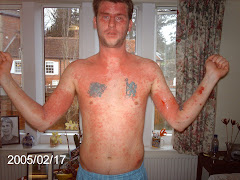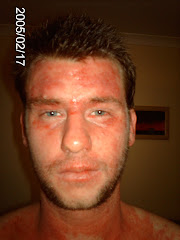Phototherapy
Phototherapy: A Treatment Option for Some Types of Eczema
Phototherapy exposes a patient to ultraviolet (UV) light for a controlled amount of time and may be prescribed to treat moderate to severe:
Atopic dermatitis
Contact dermatitis
When prescribed, phototherapy is likely to be part of a total treatment plan. Typically, a treatment plan includes lifestyle modifications to prevent flare-ups, topical (applied to the skin) treatment, and if needed, stronger therapy, such as medication that is swallowed or injected.
Two types of phototherapy are used to treat eczema:
UV light therapy
PUVA (also called chemophototherapy)
UV Light Therapy
This may be used alone or with a topical treatment, such as coal tar. Ultraviolet A (UVA), ultraviolet B (UVB) or a combination of UVA and UVB therapy may be used. During therapy, the patient's body, or just the affected skin, is exposed to the UV light. Goggles are worn during treatment to protect the eyes. Patients usually receive treatment in a dermatologist's office.
There are two types of UVB therapy:
Broadband (3-5 treatments per week)
Narrowband (2-3 treatments per week)
Broadband - This UVB therapy has been around for more than 80 years, and it is still highly effective. The biggest drawbacks are that the patient must travel between 3 and 5 times per week to a site that offers this therapy and that broadband light does not effectively treat the scalp and areas where skin folds occur.
Narrowband - This newer form of UVB therapy is called “narrowband” because it emits a narrower band of UVB wavelengths. Narrowband UVB therapy is proving more effective than the traditional broadband therapy. However, it does have the potential to produce severe burning. Like broadband, it is still not known if narrowband UVB therapy poses a long-term risk for development of skin cancer.
PUVA
PUVA combines medication with light therapy and stands for "psoralen" + "UVA". Psoralen is a prescription medication that makes the skin more sensitive to UVA rays. Before UVA exposure, the patient swallows, bathes in, or applies psoralen to the skin. After treatment, patients must wear UVA-blocking sunglasses for 1 or 2 days when exposed to sunlight because psoralen remains in the eyes for a while.
PUVA's effectiveness is limited to carefully selected patients whose condition is likely to respond to this therapy. PUVA has a number of side effects, which may include nausea, headache, fatigue, burning skin, itching, and irregular skin pigmentation. A series of treatments is usually needed, and a full course of treatment may take six months. In several studies, patients have had substantial improvements when PUVA was combined with topical corticosteroids.
Why Phototherapy Works
UV light of certain wavelengths affects the immune system. By carefully exposing patients to these UV wavelengths for specified amounts of time, dermatologists are able to prevent the exaggerated immune response that causes the inflammation.
Benefits
The beneficial effects of phototherapy vary from person to person. Phototherapy can:
Significantly improve, and even clear, atopic dermatitis. One study conducted in Germany investigated the effects of phototherapy on severe atopic dermatitis. Investigators found more than 80% of the patients with atopic dermatitis who were treated with phototherapy showed significant improvement, and in some cases, complete clearance within three weeks.
Help prevent bacterial infections, which are common in the skin of patients with atopic dermatitis.
Reduce the strength of topical corticosteroids required, and in some cases, eliminate the need for topical corticosteroids.
Risks
While phototherapy can significantly improve a patient's skin and even completely clear atopic dermatitis in some cases, phototherapy does carry these risks:
UV light is a contributing cause of skin cancer
UV light has been proven to prematurely age the skin
Dermatologists Carefully Weigh Risks and Benefits
Phototherapy is not appropriate for every patient who has eczema. It is not recommended for patients whose eczema flares when exposed to sunlight or anyone who develops a sun-induced allergic reaction. In some patients, phototherapy can worsen eczema.
Dermatologists have the medical training and experience needed to carefully weigh the risks and benefits of phototherapy to determine if this treatment is right for a patient. In considering whether or not phototherapy is appropriate, dermatologists look at a number of factors, including the patient's age, health, medical history, severity of the condition, and history of previous treatment.
Tuesday, 5 August 2008
Saturday, 26 July 2008
PHOTOTHERAPY
I had an email from Brooke, who has recently started phototherapy. Brooke is very pleased with the results she has had so far. I had will post some information on the treatment in my next post. I had UV treatment up the local hospital and it worked well for me too but unfortunately as soon as I stopped the treatment my eczema returned
Wednesday, 23 July 2008
Been very Lazy/Busy
I have been very busy at work recently and too lazy to blog once I have got home plus I have been in the process of putting in a new bathroom suit at home which I have still not finished but I am determined to keep up the blog now I am back online!!
Saturday, 3 May 2008
Thank you Candy Fu
I would like to thank Candy Fu for submitting a bio for the main site!!
I am glad it looks like the summer is starting as the sun is great for my skin
I am glad it looks like the summer is starting as the sun is great for my skin
Wednesday, 23 April 2008
Thanks Carlye
I would like to thank Carlye Schuler for submitting a bio to the www.our-eczema.com web site it is really appreciated.
Hayfever
Well, my eczema and hay fever are really doing my nut in today!. My eyes are sore and my skin is driving me mental. Just been for some fresh air and a round of golf to calm down. Drove like Woods!!
Sunday, 6 April 2008
Subscribe to:
Comments (Atom)



